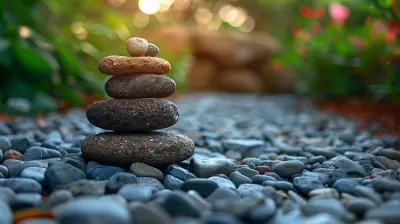The Healing Power of Stillness: Embracing Rest in a Busy World
27 June 2025
Let’s be real for a second—when was the last time you sat in complete silence, without your phone, without a million tabs open in your head, just… still? If you're like most people, the answer might be "I can't even remember." And honestly, you're not alone. Our lives are constantly moving—fast. We glorify hustle culture, measure our worth by our productivity, and somewhere along the way, we forget how to just be.
But here’s the crazy part: stillness is not laziness. In fact, it might be one of the most powerful forms of healing we barely talk about. In this noisy, always-on world, embracing rest isn't just a luxury—it's a necessity. So, let’s unpack that, shall we?
Why We Struggle to Be Still
You wake up, check your phone, scroll through emails, scan social media, rush into your day, and crash into bed feeling exhausted—but not fulfilled. Sound familiar? That go-go-go lifestyle might feel productive, but it’s slowly draining us.We’ve been conditioned to believe that stillness is wasted time. That if we’re not doing something, we’re falling behind. But here’s the truth: always being "on" burns us out emotionally, physically, and even spiritually. It's like trying to drive a car without ever turning off the engine. Eventually, it breaks down.
The Science Behind Stillness
Let’s put some hard facts behind this. Stillness—whether it’s through meditation, deep breathing, or simply sitting quietly—activates the parasympathetic nervous system. That’s the system responsible for "rest and digest." It lowers your heart rate, reduces blood pressure, and helps your body repair and regenerate.When you're always in motion, you're stuck in "fight or flight" mode. That constant stress response floods your body with cortisol, the infamous stress hormone. Over time, high cortisol levels can mess with your immune system, sleep patterns, mood, and even your gut health.
But when you pause—even for just a few minutes—you tell your body it’s safe. It switches gears, starts healing, and rebalances itself naturally.
Rest Is More Than Sleep
Okay, let’s clear this up: getting enough sleep is crucial, but rest is more than logging 7 or 8 hours at night. True rest takes on many forms. It could be mental rest, like turning off your brain from decision-making. It could be emotional rest, like allowing yourself to feel your feelings without judgment. It could even be social rest—stepping away from draining interactions.When you embrace stillness intentionally, you're giving yourself space to restore every part of your being—not just your physical body.
The Mental Health Benefits of Stillness
Ever feel like your brain is just too loud? Thoughts racing like bumper cars, anxiety buzzing in the background, and no room to breathe? Yep, that’s mental overload—and it’s real.Stillness is like hitting the mute button on the chaos. Even just five minutes of quiet can create a noticeable shift. You start to hear your own thoughts more clearly, and your nervous system gets a break.
Practices like mindfulness or simply sitting in nature can dramatically reduce anxiety and depression. You don’t have to be a monk or sit cross-legged for hours. Just allow a moment for your mind to exhale.
The Spiritual Connection
Here’s where it gets a little deeper. Stillness is not only about health—it’s about connection. When we quiet the noise around us, we can finally hear our inner voice. You know, the one that gets drowned out by social media, deadlines, and grocery lists.Whether you're religious, spiritual, or just curious about deeper meaning, stillness creates space for that connection. It's where intuition lives. It's how you remember who you really are when the world isn’t shouting at you. And let's face it—we all need more of that clarity.
How to Invite More Stillness Into Your Life
Alright, so you're sold on stillness. But how do you actually make it a part of daily life without booking a solo retreat in the mountains? Good news: it doesn’t have to be complicated.Here are a few simple ways to invite stillness into your world:
1. Start Small
Forget about diving into a 30-minute meditation. Start with just two minutes. Sit, breathe, and do nothing. Yep, nothing. No phone, no music, no agenda. Let your mind settle like a snow globe—give it time.2. Create a Stillness Ritual
This could be morning silence before emails or a nightly wind-down with candles and no screen time. Make it sacred. Protect it like your favorite playlist.3. Use Nature as a Guide
Go for a walk without headphones. Sit under a tree. Watch the clouds. Nature thrives in stillness—it doesn’t rush, yet everything gets done.4. Breathe With Intention
If your mind won’t stop spinning, anchor it with your breath. Try box breathing: four counts in, hold for four, four counts out, hold for four. Repeat. Simple, grounding, insanely effective.5. Schedule It Like You Mean It
Seriously, block it off on your calendar. If it’s not scheduled, it’s probably not happening. Make it non-negotiable—like a Zoom meeting, but for your soul.Busting Myths About Stillness
Let’s address the elephant in the room: the myths that stop us from embracing rest.Myth #1: Stillness Is Laziness
Nope. Stillness is productive in a different way. It recharges your mental battery, clears emotional clutter, and makes you better at everything else.Myth #2: I Don’t Have Time
You have time for Netflix, scrolling Instagram, or complaining about how busy you are. You can find 5-10 minutes for stillness. It’s not about having time—it’s about making it.Myth #3: You Have to Be Good at It
There’s no gold medal for sitting quietly. You don’t have to be a meditation guru. The goal isn’t perfection—it’s presence.Real Talk: My Journey With Stillness
I'll be honest—I used to hate being still. It felt uncomfortable, awkward, even guilty. But when I hit a personal burnout wall a few years ago, I had no choice.I started with breathwork. Then journaling. Then just lying on the floor and staring at the ceiling (surprisingly therapeutic). Over time, I stopped seeing rest as something I had to earn, and started seeing it as something I deserved. The result? More clarity, better sleep, deeper relationships, and a version of myself that didn’t feel like a stressed-out robot anymore.
What Happens When You Embrace Stillness
When you welcome stillness into your life, a quiet transformation happens:- You become less reactive.
- You think more clearly.
- Your creativity surges.
- You sleep better.
- You gain emotional resilience.
- You feel more connected to yourself and others.
Sounds like a pretty great deal for something that costs zero dollars, right?
Rest Isn’t Weakness—It’s Wisdom
If there's one thing you walk away with, let it be this: rest is not a sign that you're slacking. It’s a sign you’re wise enough to know your limits, brave enough to slow down, and intuitive enough to listen to your inner needs.Embracing stillness doesn’t mean abandoning your goals—it means approaching them from a place of wholeness. It teaches you that being is just as important as doing.
So go ahead. Close your laptop, sit in silence for a few minutes, and breathe. The world can wait while you return home to yourself.
You owe it to your body, mind, and soul.
Final Thoughts: Stillness Is a Superpower
We’re all searching for healing in one way or another. And while there’s no one-size-fits-all solution, stillness comes pretty close. It’s like a reset button for your entire being—quiet, free, and profoundly powerful.In a society obsessed with movement, stillness is the revolution. And the best part? You can start today. Right now. Wherever you are.
Sit. Breathe. Be.
all images in this post were generated using AI tools
Category:
Self CareAuthor:

Sophia Wyatt
Discussion
rate this article
1 comments
Kian McRae
This article beautifully highlights the importance of stillness. In our fast-paced lives, embracing rest is essential for mental and physical well-being. Thank you for sharing!
July 5, 2025 at 3:11 PM

Sophia Wyatt
Thank you for your kind words! I'm glad you found the article insightful and important. Embracing stillness is indeed vital for well-being.


